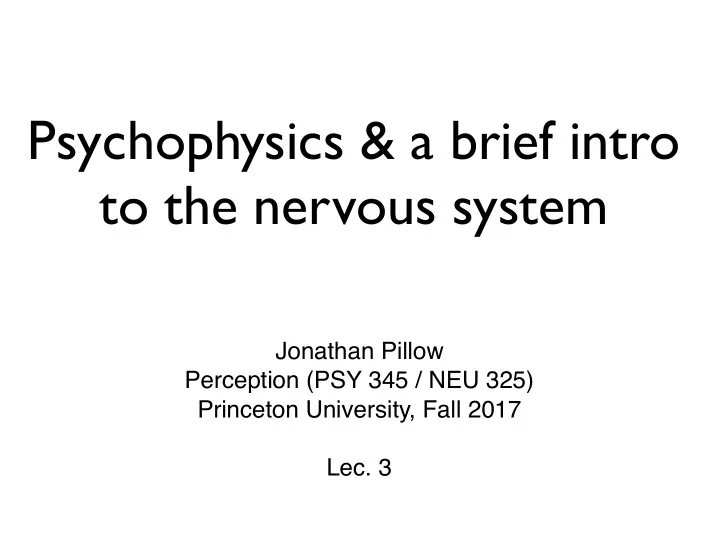

Psychophysics & a brief intro to the nervous system Jonathan Pillow Perception (PSY 345 / NEU 325) Princeton University, Fall 2017 Lec. 3
Outline for today: • psychophysics • Weber-Fechner Law • Signal Detection Theory • basic neuroscience overview
The Dawn of Psychophysics Gustav Fechner (1801–1887) often considered founder of experimental psychology psychophysics matter mind • scientific theory of the relationship between mind and matter
Fechner’s law
The Dawn of Psychophysics Ernst Weber (1795–1878) “Weber’s Law” • law about how stimulus intensity relates to detectability of stimulus changes • As stimulus intensity increases, magnitude of change must increase proportionately to remain noticeable Example: 1 pound change in a 20 pound weight = .05 is just as detectable as 0.2 pound change in a 4 pound weight = .05
The Dawn of Psychophysics Ernst Weber (1795–1878) Weber Fraction • ratio of change magnitude to stimulus magnitude that is required for detecting the change change in stimulus stimulus intensity = .05 Q: what’s the smallest change in a 100 pound weight could you detect? = .05
The Dawn of Psychophysics Ernst Weber (1795–1878) Weber Fraction • ratio of change magnitude to stimulus magnitude that is required for detecting the change Just-Noticeable Difference (JND) • smallest magnitude change that can be detected = .05 Q: what’s the smallest change in a 100 pound weight could you detect? = .05
Look at Fechner’s law again:
A little math (don’t freak out) Fechner’s law: percept stimulus intensity intensity differentiate both sides change in stimulus Weber’s law: intensity change in percept intensity So detectability (“how much the percept changes”) is determined by the ratio of stimulus change dR to stimulus intensity R. (so, it’s really the same law!)
Weber-Fechner Law my rating: this is very deep / important!
Stevens’ Power Law
Stevens’ Power Law • subjective • based on rating data • no “right” answer: just a mapping between one unknown scale (‘pain’) and another unknown scale (‘numbers’) (my rating: “meh”)
Test yourself: at which intensity are changes most detectable? A B C
For this stimulus/sensation relationship, which stimulus changes are most detectable? A B C
How to measure perception?
müller-ly er illusion
“percept” “percept” is internal
f ( x ) x blabla
Psychophysics • detection (yes/no) • discrimination (e.g., bigger than) • estimation (report the stimulus exactly) All provide indirect measure of internal mental state!
Detection perfect threshold
Detection perfect threshold noise
psychometric function • relates physical quantity to the probability of detecting it
Signal detection theory : A psychophysical theory that quantifies the response of an observer to the presentation of a signal in the presence of noise ( On board )
Figure 1.16 Detecting a stimulus using the signal detection theory (SDT) approach (Part 1)
Figure 1.16 Detecting a stimulus using the signal detection theory (SDT) approach (Part 2)
Figure 1.17 Sensitivity to a stimulus: The separation between the distributions of response to noise alone and to signal plus noise
Figure 1.18 For a fixed d ʹ , all you can do is change the pattern of your errors by shifting the response criterion
Signal detection theory � Hit : Stimulus is presented and observer responds “Yes” � Miss : Stimulus is presented and observer responds “No” � False alarm : Stimulus is not presented and observer responds “Yes” � Correct rejection : Stimulus is not presented and observer responds “No”
Signal Detection Theory Terms to know: “noise” distribution : values arising when stimulus not present “signal” distribution : values arising when signal + noise present Type I error : rate of “false alarms”, or false positives Type II error : rate of “misses”, or false negatives psychometric function : describes probability of saying “I heard it” as function of stimulus intensity
Brief Neuroscience Intro:
the brain, yo
neuron dendrites of target axons of sensory neurons receptor neurons • membrane is polarized : voltage difference between inside and outside (neuron is like a battery)
Spikes - currency of the nervous system • channels open • current flows in • membrane becomes depolarized
spike propagation
synapse action potential triggers release of vesicles transmitter molecules bind to receptor post-synaptic electrical signal
measuring neural activity • Invasive methods - electrophysiology (electrodes) - imaging (voltage sensitive dyes) • non-invasive methods - fMRI (functional magnetic resonance imaging) - EEG (electroencephalography) - MEG (magnetoencephalography)
You can safely ignore (for now) • method of constant stimuli / method of adjustment • ROC curves • Fourier analysis (though we will come back to it!) • Cranial nerves (Fig 1.20) • brain anatomy (Fig 1.21, but we will come back as needed)
Summary • Weber-Fechner law • Stevens’ power law • psychophysics • psychometric function • signal detection theory: threshold, criterion, Hit/ Miss, FA/CR, d’ (i.e., “d-prime”) • spikes, synapses, neurotransmitter
Next: Read Chapter 2
Recommend
More recommend